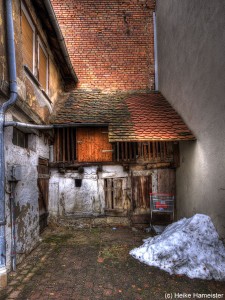Externsteine, Teutoburg Forest
The Externsteine are a distinctive rock formation located in North Rhine Westphalia (Germany) in the Southern part of the Teutoburg Forest. The formation is a tor consisting of several tall, narrow columns of rock which rise abruptly from the surrounding wooded hills and are a natural outcropping of five sandstone pillars. All pillars have been modified and decorated by humans over the centuries and were a centre of religious activity for the Teutonic peoples and their predecessors prior to the arrival of Christianity in northern Europe. At the top of the tallest stone is a chamber, formerly used for sacrifices and the little decoration remains apart from one wall with a circular hole cut into it. Early studies have shown that this is some form of calendar. On the exact day each year when summer turns to winter, the sun shines exactly onto this hole.
Today, the Externsteine are one of the most frequently visited nature reserves in Westphalia.
Hermannsdenkmal, Germany
The Hermannsdenkmal (“Herman the German”, “Hermann monument” engl.) is a monument (53.46 m tall) located in North Rhine Westphalia (Germany) in the Southern part of the Teutoburg Forest and stands on the densely forested and 386 m tall Teutberg. The construction was started in 1841 and finished 1875 with the help of substantial funds from the state of Prussia. The monument is decorated with the Cherusci war chief Hermann (“Arminius” latin) and presents the Battle of the Teutoburg Forest in which the Germanic tribes a decisive victory in 9 AD over three Roman legions under Varus.
Hermann’s sword has the following inscription:
Deutsche Einigkeit, meine Stärke – meine Stärke, Deutschlands Macht.
German unity (is) my strength – my strength (is) Germany’s might.
The statue is one of the most popular tourist destinations in Germany with over 130,000 visitors a year and statue’s base may be climbed up and affording wide landscape views.
St. Johannis Kirche (St. John’s Church), Herford
Herford is a city in North Rhine-Westphalia (Germany), located near the Teutoburg Forest. The town was founded in 789 and was a member of the Hanseatic League in late medieval times.
All photos were taken in the St. John’s Church (St. Johannis/Neustädter Kirche), a late Gothic hall church from 1340.
Frankfurt am Main (Hesse), Germany
Frankfurt (a. M.) is the largest city in Hesse and the 5th largest city in Germany. Situated on the River Main (“ford” engl.), Frankfurt is the largest financial centre in continental Europe and it is the home of a number of major banks and brokerages. Most of these banks are situated in skyscrapers and contain the two tallest skyscrapers in the European Union, the Commerzbank Tower and Messeturm.
The Römer (“Roman” engl.) is a set of three buildings located in the Römerberg and it was the city hall of Frankfurt for 600 years.
The famous old opera house (Alte Oper) was built in 1880 by the architect Richard Lucae and the building was one of the major opera houses in Germany until it was heavily damaged in World War II. Until the late 1970s it was a ruin, with the nickname: “Germany’s Most Beautiful Ruin”. The public pressure resulted in a fully reconstructed and reopened Opera in 1981. The inscription on the frieze says: “Dem Wahren, Schönen, Guten” (“To the true, the beautiful, the good”).
The IG Farbenhaus (IG Farben Building) was built from 1928 to 1930 as the headquarters for the german chemical industry conglomerate and was the largest office building in Europe and remained so until the 1950s. After World War II, the IG Farben Building served as the headquarters for the Allied Command and was returned to the German government in 1995. Today, the complex houses the Westend Campus of the University of Frankfurt, which includes the departments of Philosophy, History, Theology, Art and Music, Modern Languages and Linguistics, Cultural and Civilization Studies, the Center for North American Studies and the Fritz-Bauer-Institute.
Church in Groß-Umstadt
These photos were taken in Groß-Umstadt (Hesse, Germany) in the city church. Groß-Umstadt is near Darmstadt and Frankfurt (Main) and at the northern border of the Odenwald.
The secretive door
The photo was taken in Groß-Umstadt (Hesse) behind the city church. Groß-Umstadt is near Darmstadt and Frankfurt (Main) and at the northern border of the Odenwald.
The shabby backyard
The photo was taken in a small backyard in Groß-Umstadt (Hesse), Germany. Groß-Umstadt is near Darmstadt and Frankfurt (Main) and at the northern border of the Odenwald.
Staatstheater Darmstadt
The Staatstheater was found in the year 1972, when the new building was finished at the Georg-Büchner-Platz and was renovated in the years 2002 – 2006.
Mathildenhöhe, Darmstadt
These photos were taken after a very snowy day in Darmstadt (Hesse), Germany.
The artists’ colony “Mathildenhöhe” was founded in 1899 by Ernest Ludwig, Grand Duke of Hesse and the first exhibition of the artists’ colony took place in 1901. Ernest Ludwig motto was: “My Hesse should flourish, and the art in Hesse too” and he brought together several artists of the Art Nouveau (Jugendstil) in Darmstadt: Peter Behrens, Hans Christiansen, Ludwig Habich and Joseph Maria Olbrich.


